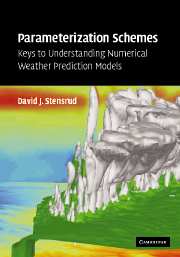Book contents
- Frontmatter
- Contents
- Preface
- List of principal symbols and abbreviations
- 1 Why study parameterization schemes?
- 2 Land surface–atmosphere parameterizations
- 3 Soil–vegetation–atmosphere parameterizations
- 4 Water–atmosphere parameterizations
- 5 Planetary boundary layer and turbulence parameterizations
- 6 Convective parameterizations
- 7 Microphysics parameterizations
- 8 Radiation parameterizations
- 9 Cloud cover and cloudy-sky radiation parameterizations
- 10 Orographic drag parameterizations
- 11 Thoughts on the future
- References
- Index
6 - Convective parameterizations
Published online by Cambridge University Press: 05 September 2013
- Frontmatter
- Contents
- Preface
- List of principal symbols and abbreviations
- 1 Why study parameterization schemes?
- 2 Land surface–atmosphere parameterizations
- 3 Soil–vegetation–atmosphere parameterizations
- 4 Water–atmosphere parameterizations
- 5 Planetary boundary layer and turbulence parameterizations
- 6 Convective parameterizations
- 7 Microphysics parameterizations
- 8 Radiation parameterizations
- 9 Cloud cover and cloudy-sky radiation parameterizations
- 10 Orographic drag parameterizations
- 11 Thoughts on the future
- References
- Index
Summary
Introduction
Moist convection comes in many shapes and sizes. For some people, memories of severe thunderstorms with strong and gusty winds, heavy rainfall and lightning probably come to mind when thinking about convection. Sometimes these thunderstorms merge over time and form organized lines of deep convective storms with trailing stratiform rainfall regions. However, others may remember stratocumulus clouds that often form near coastlines when thinking of convection, or the clouds and attendant rainfall that often occur with the passage of a cold front. Of course, all of these examples describe moist convection – widely varying in shape and size, but similar in that the cloud motions generally are vertical and driven by buoyancy forces.
Moist convection is important to the prediction of the atmospheric circulation for a number of reasons. Large-scale horizontal gradients of latent heating produced by deep moist convection help to drive vertical circulations that are large scale, such as the Hadley and Walker cells. Deep convection also is a key component in the El Niño Southern Oscillation (ENSO), which can strongly influence seasonal climate in the northern hemisphere. During ENSO events, the sea surface temperatures in the tropical eastern Pacific are warmer than normal. Deep convection develops in association with this warm surface temperature anomaly, releasing latent heating in a deep atmospheric column and producing upper-level divergence. The upper-level divergence produced by the convection then helps to excite a train of Rossby waves that alter the hemispheric flow patterns (Tribbia 1991).
Information
- Type
- Chapter
- Information
- Parameterization SchemesKeys to Understanding Numerical Weather Prediction Models, pp. 185 - 259Publisher: Cambridge University PressPrint publication year: 2007
